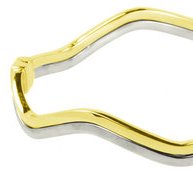Gold
It takes an exquisite and spectacular prize to encourage an athlete to train a lifetime; that reward is gold. Gold can be worn any time of the year to brighten up whichever outfit you please. Gold makes for great gifts and fine investments because it never depreciates in value. Some people have chosen to invest their paper money in gold to avoid the possibility of their money losing value. The great thing about gold is that it can be given to anyone, at any age, anytime, and will always be received with gratitude. outfit you please. Gold makes for great gifts and fine investments because it never depreciates in value. Some people have chosen to invest their paper money in gold to avoid the possibility of their money losing value. The great thing about gold is that it can be given to anyone, at any age, anytime, and will always be received with gratitude.
Gold will not tarnish, rust, or decay. Though it is a durable substance, it is also the most malleable of all metals. Gold is such a flexible and elastic material, that a single ounce can be hammered into 300 square feet. Gold is a mixture of elements including, nickel, copper, silver, and zinc. The value of gold is measured according to its purity and its purity is measured in karats (Kt). Karats measure how much pure gold is in each piece. For Example, 24 karats is considered 100% gold and 10 karats contains only 41.7% gold.
A Simple Guide To Gold Karat (Kt) Classifications
24 karat = 100% gold
18 karat = 75.0% gold
14 karat = 58.5% gold
10 karat = 41.7% gold
It is important when buying a gold piece of jewelry to take into consideration how much the jewelry will be worn. If it is believed that the piece will be worn every day, a lower karat would be more beneficial than a higher karat. Gold is a very malleable substance, and it is the other alloys within the metal that ensure its toughness and durability. People who have allergies from jewelry should stick to buying 14 karat gold and higher because the metal is less concentrated with the other alloys. The higher the concentration of nickel in a piece of gold jewelry, the more likely it is that someone with allergies will react to the piece.
The Colors of Gold Explained
Gold comes in three colors: yellow, white, and pink. The color of gold is determined by two factors:
1. The combination of elements within the metal, and
2. the percentage of each element within the metal.

Yellow gold is the most common of the three colors because gold comes out of the ground yellow. Yellow gold will vary in shades depending on which country it originates from. Gold from Italy, for example, will have a very deep tint of yellow gold, whereas Canada’s gold will be a little more pinkish in tone. The yellow of the gold also depends on how many other alloys are in the metal.
White gold is a little more complex than yellow gold. Because pure gold is yellow, the color white comes from other elements within the metal. White gold cannot come in 24 karat. However, it can appear just as brilliant because all white gold is plated with rhodium. With time the rhodium can fade away, making the white gold jewelry appear dull. The good news is that white gold can be re-dipped with rhodium by any qualified jeweler, usually at a low cost. Pink gold or rose gold appears to have a pinkish hue because it is more concentrated with copper. In addition to the standard colors some jewelry is offered in two, or even three, tones of gold. This usually means it combines white gold with yellow gold to give the piece a unique color appeal.
The top three gold producing countries are South Africa, United States, and Australia, respectively. Gold is one of the most desired metals across the world.
- Click Here to View Our Gold Products | 